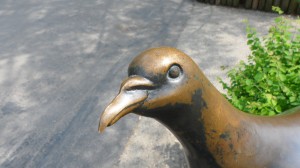 On this day in 1900, the last wild Passenger Pigeon (perhaps) was shot in Ohio. It ended up in the Columbus Ohio History Center where it is still on display – and goes by the name of Buttons because when first stuffed, buttons were used for its eyes.
On this day in 1900, the last wild Passenger Pigeon (perhaps) was shot in Ohio. It ended up in the Columbus Ohio History Center where it is still on display – and goes by the name of Buttons because when first stuffed, buttons were used for its eyes.
Here are some lightly edited extracts from Chapter 4 of A Message from Martha:
‘I left Cincinnati and drove the 94 miles to Piketon, Ohio, on a sunny Sunday evening through Ohio countryside with lines of small hills running from north to south separated by wide flat valleys. The hills are mostly wooded with oaks and beech and the valleys are cultivated with corn and wheat. Piketon is small but my room in the Town and Country Motel was clean and cheap.
Just down the road was another location I was determined to visit, so as soon as I’d checked in I set out to find it. Chris Cokinos describes tracking down this location in his book, which I recommend, about extinct American birds: Hope is the Thing with Feathers (it’s a line from an Emily Dickinson poem). Cokinos poked around in dusty rooms consulting dusty ledgers to discover the area of land where a teenage boy, Press Clay Southworth, shot the last wild Passenger Pigeon in March 1900. He’d done the hard work, and it was easy for me to follow the directions in his book to get to the area.
Driving south from Piketon on the 23, after just about four miles I turned left and crossed the railway line by ‘Carter Kitchen and Bath’ and then turned right to go down Wakefield Mound Road. I was keen to see where the Passenger Pigeon ceased, as far as we know, to be a wild bird. As I headed towards Wakefield it seemed to my English eyes a typically American scene of trailers and wooden houses surrounded by freshly cut lawns with the occasional Stars and Stripes hanging proudly in the yard. Admittedly there was a uranium enrichment plant over the brow of the hill – but apart from that it seemed a pretty typical scene.
Heading south on Wakefield Mound Road I passed a sign advertising ‘Tony’s House of Hope’, which is seeking donations and will provide a women’s facility and classroom. This is just past the United Steelworkers’ office with its sign saying ‘Unity and Strength for Workers’.
At Wakefield I was faced with a choice of route. Big Run Road is wide and heads towards the energy plant, whereas Salt Creek Road is small and residential. I could go up either and then turn onto Rapp Hollow Road and come back on the other road. I decided to drive up Big Run Road and take the right turn along Rapp Hollow Road before turning sharp right onto Salt Creek Road, where I passed the Wakefield Freewill Baptist Church (Pastor Lowell King) with a goodly crowd of Dodges, Fords, Chryslers and Jeeps parked outside, suggesting that Pastor King had a good congregation for his 6:30 pm service. It was now nearly 8 pm.
Inside the six-mile loop that I had performed was the farmland where the last Passenger Pigeon in the wild had been shot. There were Mourning Doves flying over and Eastern Bluebirds nesting in boxes in gardens. On a sunny Sunday evening some families were letting Dad burn the meat on barbecues outside and other dads had donned baseball mitts and were throwing balls with their sons. Each house, whether well-kept or running a bit to seed, had a well-cut lawn and a mailbox on the roadside. There were basketball hoops on some house-ends and dogs on leashes in some yards. A few houses had an old metal water pump in the middle of the lawn.
The surroundings were wooded hills just like many other parts of southern Ohio, but also just like many other parts of the eastern USA. I hadn’t expected anything different but just as ordinary-looking people can sometimes do amazing things, this ordinary-looking loop of American road contained the place where the Passenger Pigeon in effect was made extinct. The great abundance of the species ended right here in March 1900 as much as it ended in Cincinnati Zoo 14 years later. No Passenger Pigeon was reliably reported from the wild after Press Clay Southworth, aged 14, popped one off in this ordinary patch of Ohio farmland and woodland.

Although we certainly know that Martha was the very last Passenger Pigeon on Earth it is much more difficult to be sure that Buttons was the last one in the wild. Perhaps similar scenes were played out in similar corners of the USA by similar boys with similar firearms, but if they were then they didn’t occur much beyond 1900.
I woke early the next day and every vestige of jet lag seemed to have dropped away. I headed back to see whether the area where Buttons was shot looked any different on a Monday morning from a Sunday evening.
In his research, Chris Cokinos discovered that Buttons had been shot by Press Clay Southworth on 24 March 1900 on the family farm. The bird had been stuffed and mounted by a Mrs Barnes, and was donated to the Ohio Historical Society by her husband, Mr Clay Barnes, Pike County’s ex-sheriff, on 27 February 1915 – almost exactly six months after Martha’s death.
Cokinos tracked down an account of the killing of Buttons by Press Clay Southworth himself, written in 1968 at the age of 82. He had been feeding cattle in the barn yard and saw a strange bird fly up and perch in a tree. As he was only 14 he had to persuade his mother to let him have the 12 gauge gun, and with it he brought down the strange pigeon from high in the tree. His mother identified it as a Passenger Pigeon because she remembered seeing them as a girl, as did his father later, and he took the bird to be stuffed.
This little tale summed up so much about the Passenger Pigeon. A country boy, presumably accustomed to seeing birds around the farm, saw an unfamiliar bird, and when he shot it and presented it to his parents they both recognised it from their childhood. In one generation this species had gone from familiar to unrecognised – and indeed to extinct in the wild when that shot was fired. And on that date in late March a few decades earlier there would have been millions of Passenger Pigeons courting, building nests and even perhaps laying the earliest eggs of the season.
As I drove around the loop road again I felt I wanted to knock on doors and tell people that where they lived was special in a rather sad way. There was no sign that the inhabitants of this area had the faintest idea of the role that their neighbourhood had played in the extinction of the commonest bird on Earth. No brown historical marker marked the scene, and there was no ‘Passenger Pigeon Bar’ to commemorate the event.
 It was nearly 9 am. I waited in my car across the street for a few minutes for the Wakefield Grocery to open. Maybe I could ask in there about whether there was any lingering remembrance of the Passenger Pigeon locally. When I entered, a man was vacuuming the floor noisily and the woman behind the till didn’t look in the mood for talking. I bought a Mound Bar and left without raising the subject – it didn’t seem an opportune moment. This was Monday 20 May 2013, and Wakefield, Ohio, had forgotten the events of Tuesday 24 March 1900. In fact, the world had forgotten the Passenger Pigeon almost completely. And I guess that is too often what we mean by ‘Progress’ – forgetting the past rather than incorporating it in our present.
It was nearly 9 am. I waited in my car across the street for a few minutes for the Wakefield Grocery to open. Maybe I could ask in there about whether there was any lingering remembrance of the Passenger Pigeon locally. When I entered, a man was vacuuming the floor noisily and the woman behind the till didn’t look in the mood for talking. I bought a Mound Bar and left without raising the subject – it didn’t seem an opportune moment. This was Monday 20 May 2013, and Wakefield, Ohio, had forgotten the events of Tuesday 24 March 1900. In fact, the world had forgotten the Passenger Pigeon almost completely. And I guess that is too often what we mean by ‘Progress’ – forgetting the past rather than incorporating it in our present.
It was in that sombre mood that I started my search for a breakfast that would both fill me up and cheer me up – but some time later I actually had the worst breakfast I’ve ever had in the USA. So the names and locations in this tale have been changed to protect the guilty. But the food was not the worst part.‘
[registration_form]
What a great book, I forgot just how much I enjoyed it!
Mark, thanks for this piece and the interesting vignettes about ordinary America. They are a simultaneous mixture of strangeness and familiarity; an incongruous backdrop to an incomprehensible act of destruction. Very good writing: another book to go on the reading list.
In their appearance the nestlings of the dove family remind us of another Columbidae, the Dodo.
Perhaps that’s a bit off topic or maybe not if it serves to remind each one of us how un-sapient Homo sapiens can be.
Great piece, enjoyed re-reading. Interesting timing given the prediction yesterday of the ‘extinction’ of ash in Europe – a previously abundant and successful species wiped out, surely it couldn’t happen?
https://jecologyblog.wordpress.com/2016/03/23/the-future-for-ash-looks-bleak-says-journal-of-ecology-species-survey/